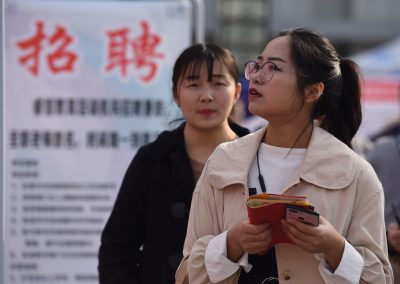China
Gender discrimination in China’s labour income

Author: Jane Golley, ANU, Yixiao Zhou, ANU, and Meiyan Wang, CASS
Income inequality has been a persistent feature of China’s rapid growth and development since the late 1970s. A gender earnings gap has persisted in urban China throughout the reform period despite a narrowing of the gender gap in educational attainment in recent years. Most of the earnings gap is attributable to gender discrimination.
Market reforms have not reduced gender discrimination in the rural economy either. There has been some reduction in wage discrimination in the most marketised sectors of Chinese rural industry since the 1980s, but discrimination still accounts for two-thirds of the wage differential in these sectors. This suggests a more serious gender problem than in other industrial and developing economies.
The urban female labour force participation rate dropped to 57 per cent in 2009 from 78 per cent in 1988. This can be attributed to the intensified pressures placed on women arising from their dual responsibilities as unpaid family carers and income earners during the economic transition.
During the 1980s and 1990s, women accounted for one-third of Communist Party members. By 2017 they accounted for one-quarter. Communist Party membership is associated with earnings that were 6 per cent and 10 per cent higher for men and women, respectively, in 1995. There has also been an increasing wage reward for party membership — it rose from 29 per cent in 1988 to 33 per cent in 1999. The higher return for women did not reduce the earnings gap because of lower female membership numbers.
There are various circumstances that contribute to inequality of opportunity in China’s individual labour income. Predominant among these circumstances are the occupation and education of one’s father, alongside one’s geographical location, ethnicity and rural or urban hukou status. But ranking above all of these in China’s case is the importance of gender — a point that does not hold in any other country for which similar analyses have been conducted.
Besides circumstances, an individual’s effort — or choices — also impacts on labour market outcomes. Higher levels of education, non-agricultural occupations, Communist Party membership and non-migration are associated with higher income. Some disparities in gender inequality reflect women working fewer hours or in different occupations. For example, some 40 per cent of Chinese women and 28 per cent of men work in agriculture. Still, whether this comes down entirely to a matter of choice is debatable.
Marriage (considered a choice in most cases) is interestingly associated with higher average income for men, but lower income for women — although this is only true in rural China. Close to three-quarters of married males in rural China state that they never or rarely cook, 80 per cent never or rarely wash dishes and 82 per cent never or rarely do washing or cleaning — all significantly higher percentages than their urban counterparts. This suggests a relatively weak position of rural women in intra-household bargaining relating to the time allocation for housework.
Measures to assist young women to exit the agricultural sector and find off-farm employment would improve their earnings potential in the future. Ongoing reforms to the hukou system of household registration to ensure that rural migrants are not discriminated against in urban areas would also equalise the opportunities they face with those of their urban counterparts.
The importance of marriage and its different impact on the annual incomes of rural men and women mean China’s ‘gender discrimination’ begins in the home. The gender divide in household chores is indicative of the costs Chinese married women bear disproportionately.
Efforts to improve childcare systems and grant paternity and maternity leave are equal opportunity policies that could improve the situation, especially in rural areas. So would a cultural shift towards equal contributions by men and women to chores within the household.
Jane Golley is Associate Professor and the Director of the Australian Centre on China in the World, College of Asia and the Pacific, The Australian National University.
Yixiao Zhou is a Senior Lecturer at the Crawford School of Public Policy, the College of Asia and the Pacific, the Australian National University.
Meiyan Wang is Professor at the Institute of Population and Labor Economics, the Chinese Academy of Social Sciences.
This article is abridged from Jane Golley, Yixiao Zhou and Meiyan Wang’s ‘Inequality of…
China
China’s November 2024 Economy: Navigating Mixed Signals and Ongoing Challenges

In November 2024, China’s economy exhibited mixed results: industrial production rose by 5.4%, while retail sales grew only 3%, below forecasts. Fixed asset investment also faltered. Policymakers are anticipated to introduce measures to stimulate domestic demand and combat deflation.
China’s economy showed mixed performance in November 2024, with industrial production and exports showing resilience, while retail sales and fixed asset investment underperformed, amid ongoing challenges in the property sector. Policymakers are expected to implement targeted fiscal and monetary measures to boost domestic demand and address deflationary pressures.
The National Bureau of Statistics (NBS) has released China’s economy data for November 2024, revealing a mixed performance across key indicators. Retail sales grew by 3 percent year-on-year, a significant slowdown from October’s 4.8 percent growth and well below the 4.6 percent forecast. Industrial production, however, showed resilience, rising by 5.4 percent and exceeding expectations of 5.3 percent growth.
The property sector continued to drag on the broader economy, with real estate investment contracting by 10.4 percent for the January-to-November period, further highlighting the challenges in stabilizing the sector. Fixed asset investment also fell short of expectations, growing by 3.3 percent year-to-date, down from 3.4 percent in October.
In November, China’s industrial value added (IVA) grew by 5.4 percent year-on-year (YoY), slightly accelerating from the 5.3 percent recorded in October. This modest improvement reflects continued recovery in key industries, supported by recent stimulus measures aimed at stabilizing the economy.
The manufacturing sector led the growth, expanding by 6.0 percent YoY, while the power, heat, gas, and water production and supply sector grew by 1.6 percent. The mining industry posted a 4.2 percent YoY increase. Notably, advanced industries outpaced overall growth, with equipment manufacturing and high-tech manufacturing rising by 7.6 percent and 7.8 percent YoY, respectively, underscoring the resilience of China’s innovation-driven sectors.
Key product categories showed robust output gains in November:
From January to November, IVA increased by 5.8 percent YoY, maintaining steady growth over the year despite headwinds from a slowing property market and external uncertainties.
| This article was first published by China Briefing , which is produced by Dezan Shira & Associates. The firm assists foreign investors throughout Asia from offices across the world, including in in China, Hong Kong, Vietnam, Singapore, and India . Readers may write to info@dezshira.com for more support. |
Read the rest of the original article.
China
Ukraine war: 10% of Chinese people are willing to boycott Russian goods over invasion – new study

Since Russia’s 2022 invasion of Ukraine, some Chinese citizens express dissent through potential boycotts of Russian goods, reflecting a complex relationship despite government support for Russia.
Since Russia invaded Ukraine in 2022, the Chinese government has been criticised for its refusal to condemn the war. In 2024, the economic and diplomatic relationship between the two nations appears stronger than ever.
Because of strict censorship and repression imposed by the Chinese Communist Party (CCP), it is difficult to know the extent to which the general public shares their government’s support of Putin’s regime. But a newly published study I carried out with colleagues found that more than 10% of Chinese people surveyed were willing to boycott Russian goods over the war in Ukraine.
This is a surprisingly large figure, especially since existing surveys indicate that Chinese people hold a broadly positive view of their neighbour. We used a representative sample of 3,029 Chinese citizens for this research, to dig into public attitudes to Russia. The survey was done in 2022 after the Ukraine invasion.
We were aware that due to widespread censorship, our participants might not be willing to give honest answers to questions about Russia’s actions in Ukraine. They might also not feel safe to do that in a regime where disagreement with the CCP’s position is often met with harsh punishment. This is why we asked them to tell us if they would be willing to boycott Russian products currently sold in China.
We felt this question was a good indicator of how much the participants disapproved of Russian foreign policy in Ukraine. More importantly, we were also curious to find out whether Chinese citizens would be willing to take direct political action to punish Russia economically for its aggressive behaviour.
In our study, we split respondents into the three different ideological groups in China: “liberals”, who support the free market and oppose authoritarianism; “the new left”, who sympathise with the policies pursued in China under Mao Zedong; and “neo-authoritarians”, who believe the Russian-Ukrainian conflict is an extension of the rivalry between authoritarian China and the liberal United States. These groups were based on the main political beliefs in China.
We found that liberals were most likely to say they were willing to boycott Russian products. Liberals believe that China should work with, rather than against, western democracies. They also place a high value on human rights and democratic freedoms. Because of their beliefs, they are likely to think that Russia’s actions against Ukraine were unprovoked, aggressive and disproportional.
Chinese and Russian economic and diplomatic relations seem closer than ever in 2024.
American Photo Archive/Alamy
The new left and neo-authoritarians we surveyed were more supportive of Russian products. The new left see Russia as a close ally and believe that Nato’s expansion in eastern Europe was a form of aggression. Neo-authoritarians, on the other hand, believe that supporting Russia, an allied autocracy, is in China’s best interest.
Boycotting Russian goods
Asking Chinese participants if they are willing to boycott Russian products might seem like a simple matter of consumer preferences. However, our study reveals a great deal about the way in which regular citizens can express controversial political beliefs in a repressive authoritarian regime.
Boycotting products of certain companies has long been studied in the west as a form of unconventional political action that helps people express their beliefs. However, in the west, boycotting certain products is simply one of many ways people are able to take political action. In a country such as China, boycotting a Russian product might often be the only safe way to express disagreement with the country’s actions.
This is because citizens do not have to tell others they chose not to buy a product, and their actions are unlikely to attract the attention of the authorities.
Since Russian goods are readily available to Chinese consumers and China is encouraging more Russian exports to reach its market, the Russian economy could be significantly affected by an organised boycott campaign in China. The considerable level of support for a boycott expressed by some of our participants, as well as previous acts of solidarity with Ukraine in China, suggest that such a campaign could already be taking place in the country.
This could harm Russia because it regularly exports a number of different products such as meat, chocolate, tea and wine to China. These goods made up 5.1% of China’s total imports in 2023 – and this figure is likely to increase if Russia becomes more isolated from the west, and therefore more dependent on China for its trade.
While 5.1% of the Chinese market might seem like a low figure, China is home to over 1.4 billion people. In this context, even a small boycott could result in a serious loss to Russian companies.
Our research shows that Chinese citizens don’t always support the official position of the communist party. It also shows that many people there will express even the most unpopular political opinions – if they can find a safe way to do it.
This article is republished from The Conversation under a Creative Commons license. Read the original article.
China
Australia Can Enhance China’s Credibility in the CPTPP
In early 2024, China sought to join the CPTPP, potentially offering modest economic benefits to Australia. Key reforms include limiting state-owned enterprise subsidies, enhancing data flows, and banning forced labor.
China’s Interest in the CPTPP
In early 2024, China expressed a keen interest in joining the Comprehensive and Progressive Agreement for Trans-Pacific Partnership (CPTPP), a trade agreement involving eleven Pacific Rim economies and the United Kingdom. This move is anticipated to yield modest economic benefits for Australia. However, it also opens the door for vital reforms in areas such as the control of subsidies for state-owned enterprises, allowing free cross-border data flows, and prohibiting forced labor practices.
Economic Implications for Australia
A May 2024 report from the Australian Productivity Commission indicated that China’s accession to the CPTPP might raise Australia’s GDP by only 0.01%. This modest gain isn’t surprising, given Australia’s existing preferential trade arrangement with China through the Regional Comprehensive Economic Partnership. Nonetheless, the CPTPP encompasses more than just tariff reductions, focusing on broader trade principles and standards.
Reform Commitments Required from China
For China to become a CPTPP member, it must demonstrate adherence to high-standard rules initially developed with the country in mind. This commitment will help alleviate concerns among member nations like Japan and Canada, particularly regarding China’s economic practices and geopolitical tensions, such as those with Taiwan. Membership would necessitate reforms, including limiting SOE subsidies, enabling freer data flows, and banning forced labor, with significant penalties for non-compliance.
Source : Australia can encourage China’s credibility in the CPTPP






